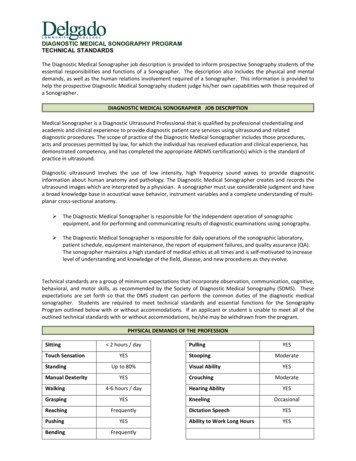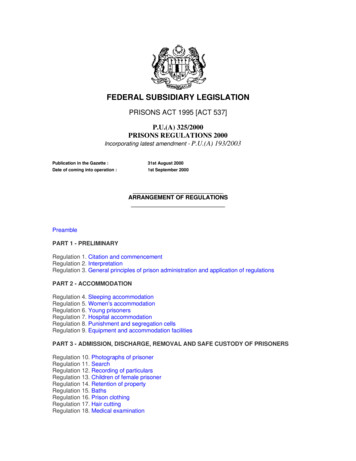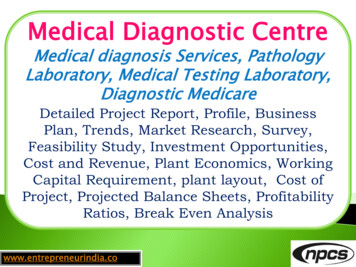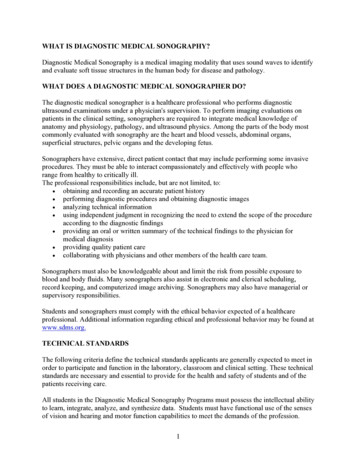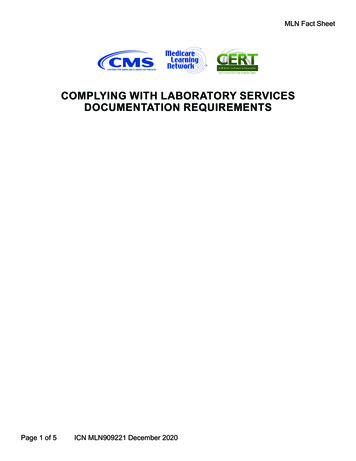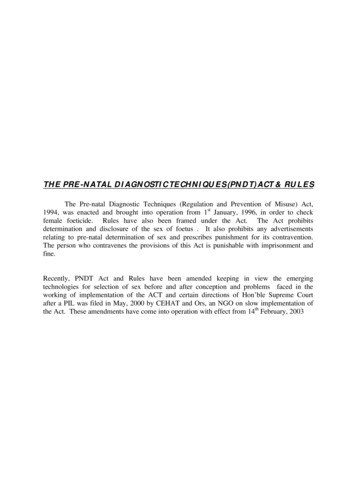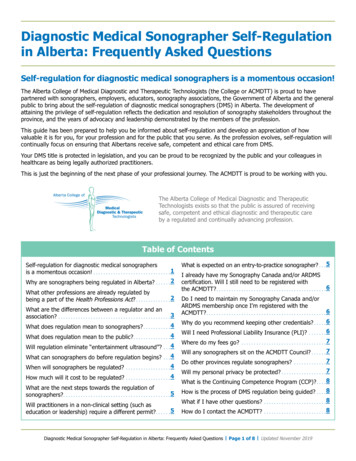
Transcription
Diagnostic Medical Sonographer Self-Regulationin Alberta: Frequently Asked QuestionsSelf-regulation for diagnostic medical sonographers is a momentous occasion!The Alberta College of Medical Diagnostic and Therapeutic Technologists (the College or ACMDTT) is proud to havepartnered with sonographers, employers, educators, sonography associations, the Government of Alberta and the generalpublic to bring about the self-regulation of diagnostic medical sonographers (DMS) in Alberta. The development ofattaining the privilege of self-regulation reflects the dedication and resolution of sonography stakeholders throughout theprovince, and the years of advocacy and leadership demonstrated by the members of the profession.This guide has been prepared to help you be informed about self-regulation and develop an appreciation of howvaluable it is for you, for your profession and for the public that you serve. As the profession evolves, self-regulation willcontinually focus on ensuring that Albertans receive safe, competent and ethical care from DMS.Your DMS title is protected in legislation, and you can be proud to be recognized by the public and your colleagues inhealthcare as being legally authorized practitioners.This is just the beginning of the next phase of your professional journey. The ACMDTT is proud to be working with you.The Alberta College of Medical Diagnostic and TherapeuticTechnologists exists so that the public is assured of receivingsafe, competent and ethical diagnostic and therapeutic careby a regulated and continually advancing profession.Table of ContentsSelf-regulation for diagnostic medical sonographersis a momentous occasion!. . . . . . . . . . . . . . . . . . . . . . . . . . . . . . . 1Why are sonographers being regulated in Alberta?. . . . . . 2What other professions are already regulated bybeing a part of the Health Professions Act?. . . . . . . . . . . . . . 2What are the differences between a regulator and anassociation? . . . . . . . . . . . . . . . . . . . . . . . . . . . . . . . . . . . . . . . . . . . . . 3What does regulation mean to sonographers?. . . . . . . . . . . 4What does regulation mean to the public?. . . . . . . . . . . . . . . 4Will regulation eliminate “entertainment ultrasound”? . . . 4What can sonographers do before regulation begins? . . . 4When will sonographers be regulated? . . . . . . . . . . . . . . . . . . 4How much will it cost to be regulated? . . . . . . . . . . . . . . . . . . 4What are the next steps towards the regulation ofsonographers?. . . . . . . . . . . . . . . . . . . . . . . . . . . . . . . . . . . . . . . . . . . 5Will practitioners in a non-clinical setting (such aseducation or leadership) require a different permit?. . . . . . 5What is expected on an entry-to-practice sonographer?. . . 5I already have my Sonography Canada and/or ARDMScertification. Will I still need to be registered withthe ACMDTT?. . . . . . . . . . . . . . . . . . . . . . . . . . . . . . . . . . . . . . . . . . . . 6Do I need to maintain my Sonography Canada and/orARDMS membership once I’m registered with theACMDTT?. . . . . . . . . . . . . . . . . . . . . . . . . . . . . . . . . . . . . . . . . . . . . . . . 6Why do you recommend keeping other credentials?. . . . . 6Will I need Professional Liability Insurance (PLI)? . . . . . . . 6Where do my fees go? . . . . . . . . . . . . . . . . . . . . . . . . . . . . . . . . . . 7Will any sonographers sit on the ACMDTT Council?. . . . . . 7Do other provinces regulate sonographers? . . . . . . . . . . . . . 7Will my personal privacy be protected?. . . . . . . . . . . . . . . . . . 7What is the Continuing Competence Program (CCP)?. . . . 8How is the process of DMS regulation being guided?. . . . 8What if I have other questions? . . . . . . . . . . . . . . . . . . . . . . . . . 8How do I contact the ACMDTT? . . . . . . . . . . . . . . . . . . . . . . . . . 8Diagnostic Medical Sonographer Self-Regulation in Alberta: Frequently Asked Questions Page 1 of 8 Updated November 2019
Why are sonographers being regulated in Alberta?Sonographers have been asking for the privilege to self-regulate for decades in Alberta and across Canada. After thegeneration of significant momentum within the profession of sonography, sonographers approached the government andapplied for regulation of DMS for the protection of the public in Alberta.Sonography is integrated into the suite of medical diagnostic and therapeutic services in the healthcare system. A robuststakeholder consultation affirmed the public perception that it should be regulated alongside other modalities in medicaldiagnostic and therapeutic services.In 2014, Alberta Health approved the Alberta Diagnostic Sonographers Association (ADSA) and the Alberta College ofMedical Diagnostic and Therapeutic Technologists (ACMDTT) joint submission for regulating sonographers.Diagnostic medical sonography is a well established profession. Regulating sonographers will enable patients, employersand other members of the public to: Verify the professional registration status of their healthcare provider Expect their complaints to be resolved in a fair and transparent manner through the regulatory body Expect the regulatory body to manage public concerns about unsafe and unprofessional practiceFor sonographers, this represents a significant benefit: Recognition as a profession A protected title under the law A practice permit enabling them to practice legally within the province of Alberta, and validity that they meet entryto-practice requirements Assurance of the standards of the profession being enforced, and unprofessional conduct being appropriately dealt with Benefit of knowing that the public is assured of service from competent, ethical and safe professionalsIn 2016, the Health Professions Act was amended to include DMS to be regulated through the ACMDTT. This will ensurethat the public will receive safe, competent and ethical care by the regulated and continually advancing profession ofdiagnostic medical sonography.What other professions are already regulated by being a part ofthe Health Professions Act?In Alberta, regulated health professions are governed under the Health Professions Act. The Health Professions Actestablishes health regulatory colleges, which regulate the professions in the public interest. Health regulatory collegesare responsible for ensuring that regulated health professionals provide health services in a safe, professional and ethicalmanner. This includes, among other things, setting standards of practice for the profession and investigating complaintsabout members of the profession and, where appropriate, disciplining them.You may have interacted with these regulated professions (there are more): Audiology and Speech-Language Pathology Naturopathy Dentistry Nursing Dietetics Occupational Therapy Medical Laboratory Technology Pharmacy Medical Radiation Technology Physiotherapy Medicine Respiratory Therapy MidwiferyDiagnostic Medical Sonographer Self-Regulation in Alberta: Frequently Asked Questions Page 2 of 8 Updated November 2019
What are the differences between a regulator and an association?Roles of regulators and associations for practice in AlbertaAspectRegulator (e.g. ACMDTT)Association (e.g. Sonography Canada)MandateActs in the best interest of the public.Acts in the interest of the members ofa profession.AccountabilityIs accountable to the public through theprovincial government.Is accountable to its members.ActivitiesSets the scope of practice, Code of Ethics,Standards of Practice and entry-to-practicerequirements legally defined by the HealthProfessions Act for the practice of aprofession.Serves and supports its members througheducation, advocacy, professional liabilityinsurance and member benefits.Registration vs.membershipRegisters members based on legislatedcriteria. Membership is mandatory topractice.Accepts members based on associationdetermined criteria. Membership isvoluntary.Permit vs. certificationIssues permits, which are legally required topractice in the jurisdiction.Issues certification, which encompassescriteria to enter into practice.QualificationsSets registration requirements (education,experience, testing to verify competence topractice).Creates and facilitates certificationexaminations.Competency profilesApproves or selects the competencyprofile(s) for a profession.Maintains competency profile(s) for aprofession.Life-long learningRequires members to participate inlegislated programs to ensure continuingcompetence.Provides members with opportunities forcontinuing education.Standards of practicevs. enhancement ofpracticeSets legal standards of practice to ensuresafe, competent and ethical service for thepublic.Provides opportunities to augmentcompetency for members seeking to expandtheir practice.Protected titlesvs. credentialsEstablishes professional titles protectedin legislation that inform the public ofauthorized practitioners — e.g. MRT(R),MRT(T), MRT(NM), MRT(MR), ENP, DMS.Practitioners must use these titles in theirpractice.Issues credentials to those who havecompleted the certification (credential)requirements — e.g. RTR, RTT, RTNM,RTMR, RET, CRGS, CRCS, CRVS.Practitioners choose to use these titles intheir practice.Enforcement ofstandardsHas a legislated complaints and disciplineprocesses in place to address complaintsfrom the public and professional conductissues.Provides support to members throughoffering professional liability insurance (PLI).AdvocacyPerforms no overt advocacy work. Itcollaborates with government, professionalsand the public to ensure safe, competentand ethical care.Advocates for the profession in orderto effect changes to service delivery, todevelop specialty certificates and to increasepublic awareness of professional services.Diagnostic Medical Sonographer Self-Regulation in Alberta: Frequently Asked Questions Page 3 of 8 Updated November 2019
What does regulation mean to sonographers? The public is protected. The profession of DMS is more highly respected through self-regulation, which means that sonographers have beentrusted with the privilege to regulate their own profession. Sonographers participate in defining and maintaining standards of practice and professionalism within their chosenoccupation. DMS have defined standards for accountability and discipline, increasing confidence in their professional abilitiesand competencies. Having a regulatory body to establish and administer standards for registration and practice protects the public fromincompetent and unqualified practitioners.What does regulation mean to the public? Assurance that all sonographers practicing in Alberta are highly trained health professionals that meet establishedstandards at entry to practice and throughout the practice of their profession. A fair and transparent process for complaints and unprofessional conduct issues is established. The public has access to a full register for all sonographers practicing in Alberta. All sonographers are required to continue to meet professional development requirements for the profession. All sonographers have to abide by the College’s Code of Ethics and Standards of Practice.Will regulation eliminate “entertainment ultrasound”?Diagnostic fetal ultrasound should only be used where a medical benefit is expected and where such benefits outweighany foreseeable risk. Regulation may not eliminate entertainment ultrasound; however, entertainment ultrasound will beout of scope for regulated DMS, as this is not the provision of a medical health service.If a DMS performs entertainment ultrasound and something goes wrong, they may not be covered by their PLI. They mayalso be investigated for acting out of scope.What can sonographers do before regulation begins?It is in the sonographer’s best interest to be diligent in completing and submitting the Alberta Diagnostic MedicalSonographers (DMS) Roster Application before the regulation is proclaimed by the Government of Alberta. Completingthis application will ease your transition into becoming a legally registered DMS. Please note that this is voluntary andwithout a fee; payment of the application and registration fees won’t be required until registration opens.It will become unlawful for sonographers to practice without being registered with the ACMDTT when the Government ofAlberta has completed the amendments to the Medical Diagnostic and Therapeutic Technologists Profession (the Regulation).More information on the rostering procedure, including a guide and the Alberta DMS Roster Application, is available on theACMDTT DMS web page.When will sonographers be regulated?Alberta Health is currently amending the Medical Diagnostic and Therapeutic Technologists Profession Regulation (theRegulation). While it is difficult to anticipate how long this might take, it will likely be later this year. Mandatory registration/regulation of DMS will start once the Regulation comes into effect. The College will contact the sonographers on the AlbertaDMS Roster with registration information when this happens. Please visit the ACMDTT DMS web page for updates.How much will it cost to be regulated?There is a one-time initial application fee of 100, and currently an annual registration fee of 450. The initial annualregistration fee for sonographers may be pro-rated depending on the time of year the Regulation comes into effect.Diagnostic Medical Sonographer Self-Regulation in Alberta: Frequently Asked Questions Page 4 of 8 Updated November 2019
What are the next steps towards the regulation of sonographers?Once the Regulation has been amended, registration with the provincial regulator or this College will becomemandatory to practice the profession of diagnostic medical sonography in Alberta. The practice of diagnostic medicalsonography encompasses both direct clinical practice and roles such as administration, supervision, management,education and research. All qualified sonographers who operate within any of these roles are mandated by the HealthProfessions Act to become registered with the ACMDTT if they have the necessary experience, knowledge and skills topractice the profession.All sonographers who meet the registration requirements and practice in Alberta will be grand-parented into theACMDTT register, becoming regulated professionals. It is not anticipated that regulation of sonographers will haveany significant impact on practitioner availability and services to the public. The grand-parenting window will bedetermined by Alberta Health and the College. The College will alert sonographers of this development through theiremployers and partners (e.g. Sonography Canada, Alberta Health Services, physician-led community clinics and ADSA).The notification will be sent by direct email if the College has been provided the sonographer’s contact information.Announcements will also be on the ACMDTT website at acmdtt.com.Following the grand-parenting window, sonographers who apply for registration will be assessed individually in accordancewith a prescribed list of registration criteria that will be published by the ACMDTT.Upon completing the College’s registration process, regulated sonographers will receive a protected title: Diagnostic medical sonographer DMSIt will be a sonographer’s legal responsibility to use their protected title in their professional communications.Will practitioners in a non-clinical setting (such as education or leadership)require a different permit?The practice of DMS involves not only the clinical and technical aspects of the profession; it also includes, but is notlimited to, functions of supervision, education, management, research and administration. Practitioners in a clinical ornon-clinical setting will all require the same registration to practice in Alberta.What is expected of an entry-to-practice sonographer?A competency profile is a document that articulates the expected tasks and skills that an entry-to-practice professionalmust possess upon graduation. The competency profile: Provides the professional expectations of a sonographer’s practice Informs the curriculum of educational programs, the certification examination and its blueprint Is used during the program accreditation process to assess the curriculum Serves as a tool for a sonographer interested in changing or advancing their area of practice Guides employers in understanding the scope of practice for role optimization of sonographers across all care settingsA regulator has the responsibility to set entry-to-practice standards for the profession and this includes a competencyprofile. A college may set its own standard or adopt an existing profile that reflects provincial practice; for example,this College has adopted the national competency profiles developed by the Canadian Association of MedicalRadiation Technologists for our medical radiation technology specialties and has set the competency profile forelectroneurophysiology technologists, which has now been adopted nationally.The College has recently adopted the Sonography Canada national competency profile for the profession of diagnosticmedical sonography. This competency profile will be reviewed and revised by Sonography Canada in the next few yearsand any changes will be assessed by the College to ensure that this standard continues to meet Alberta expectationsfor practice.Diagnostic Medical Sonographer Self-Regulation in Alberta: Frequently Asked Questions Page 5 of 8 Updated November 2019
I already have my Sonography Canada and/or ARDMS certification.Will I still need to be registered with the ACMDTT?The Health Professions Act will require all diagnostic medical sonographers (DMS) to hold valid registration through theAlberta College of Medical Diagnostic and Therapeutic Technologists (ACMDTT) to practice in Alberta.Sonography Canada and the American Registry for Diagnostic Medical Sonography (ARDMS) are associations. Certificationfrom these organizations will no longer be sufficient to practice sonography in Alberta.The law will require all public health and physician-led community clinics to ensure that their current and futuresonographers are registered to practice through the provincial regulator, which is the ACMDTT. No sonographers will beable to practice legally in Alberta without registration with the ACMDTT.Do I need to maintain my Sonography Canada and/or ARDMS membershiponce I’m registered with the ACMDTT?It is voluntary to be a member of Sonography Canada or ARDMS to practice in Alberta. Although membership in anassociation is not mandatory, the ACMDTT encourages professionals to maintain their association membership.The College believes that membership with one’s national association provides many benefits, such as participation inan organization with a national voice, professional liability insurance* and access to more opportunities for continuingeducation.*Please note that if you are not a member of Sonography Canada , you can still obtain PLI from other sources, such asMedical Imaging Education or other organizations. The College does not endorse any specific PLI provider, but we encourageall members to consider additional personal PLI to any provided by your employer (see the next section for details).Why do you recommend keeping other credentials?If you choose to keep your Sonography Canada or ARDMS credentials, you need to maintain paying your dues to thoseorganizations. If it is likely you might want to work internationally or in another province, you may choose to maintainyour Sonography Canada or ARDMS credentials. We recommend keeping as many memberships with professionalassociations as you feel comfortable with.In Alberta, once the profession is regulated the only required title to practice will be DMS and that is maintained byregistration to practice through the ACMDTT.Will I need Professional Liability Insurance (PLI)?All regulated members must have a minimum 1,000,000 PLI and must provide confirmation of PLI through theirapplication form and annual registration renewal.The College does not provide PLI. PLI is offered through Sonography Canada membership, Medical Imaging Educationand other sources. We strongly advise that you review the nature and content of coverage of your PLI before purchasing,and make sure that that the plan is well considered.The ACMDTT encourages you to always hold your own personal PLI, in addition to your employer’s insurance: Employer policies do not always cover expenses such as legal defence in professional disciplinary matters. The employer’s insurance company may sue you for reimbursement of any money they paid out as a result of youractions. Your personal PLI also follows you if you work at multiple sites with more than one employer. When you retire or leave employment, personal PLI covers you for a period of time during which patients may stillbring a claim against you. Your employer insurance may not cover you for any advice or volunteering you do outside of your work.Diagnostic Medical Sonographer Self-Regulation in Alberta: Frequently Asked Questions Page 6 of 8 Updated November 2019
Where do my fees go?The Health Professions Act mandates that each healthcare profession collects fees from the members to meet the costs ofregulation. The law is clear that the regulator must be able to perform its regulatory mandate with the fees collected. Likeother regulatory Colleges, the ACMDTT is a not-for-profit organization that depends on the registration fees for fulfilling itsmandate.ACMDTT Council (consisting of elected members of the profession and government-appointed members of the public)oversees the financial performance of the College, including determining fees. The cost of self-regulation is transparentlyshared with all members of the College through audited financial statements in the College’s Annual Report.Under its legal obligations, the College creates, maintains and enforces standards for: Enhanced professional identity through regulation Use of a protected title – diagnostic medical sonographer (DMS) Entry to practice (competency profiles and program accreditation) Code of Ethics Standards of Practice Continuing Competence Program to practice Assessment of internationally trained applicants Managing complaints in a fair and transparent wayThe College also maintains (through legal requirements) and finances: A public register Committees that are established by statute The Council whose functions are described in the Health Professions Act Staff and office administration Databases to manage the Continuing Competence Program, registration and the Public Register Responses to practice issue questions from members/employers to safeguard the appropriate scope of practiceWill any sonographers sit on the ACMDTT Council?All of the current specialties are represented on ACMDTT Council, which oversees the work of the College. A diagnosticmedical sonographer will also sit on Council.Diagnostic medical sonographers will have an opportunity to vote for a fellow sonographer to sit on Council. The initialseat may be an appointment by Council, until the next College election cycle.Do other provinces regulate sonographers?Sonography is currently regulated in Quebec and Ontario. It is anticipated that Nova Scotia will regulate sonographerswith medical radiation technologists (MRTs) in the near future. Saskatchewan is considering this as well.Will my personal privacy be protected?The ACMDTT is governed by provincial privacy legislation, the Personal Information Protection Act (PIPA). The College iscommitted to following the guidelines set out in PIPA to ensure that personal information about our members and otherindividuals with whom we interact is protected. We have developed this Privacy Policy to ensure compliance with PIPA.For more information, please see the ACMDTT Privacy Policy web page.Diagnostic Medical Sonographer Self-Regulation in Alberta: Frequently Asked Questions Page 7 of 8 Updated November 2019
What is the Continuing Competence Program (CCP)?The Continuing Competence Program (CCP) is a mandatory component* of registration as outlined in the HealthProfessions Act and the Regulation.The annual cycle for the Continuing Competence Program begins on September 1 and continues through to August 31 ofthe following year. The CCP allows you to use many kinds of activities for your required learning, including those providedby associations like Sonography Canada and ARDMS.*Please note that CCP is not mandatory during the rostering period. Once you have a practice permit and are registeredwith ACMDTT, you will be required to comply with the CCP.How is the process of DMS regulation being guided?The ACMDTT is being guided and advised by a DMS Advisory Group and sub-groups comprised of members of the DMScommunity. This DMS Advisory Group consists of members of public health, community clinics, educational institutions,major employers, front-line sonographers and individuals affiliated with Sonography Canada and the American Registry forDiagnostic Medical Sonography (ARDMS).What if I have other questions?We hope you find this document to be helpful as you prepare for self-regulation. It was developed through the thoughtfulfeedback and questions we’ve received from sonographers throughout Alberta.If you have any questions or need clarification, we welcome you to contact us.How do I contact the ACMDTT?Alberta College of Medical Diagnostic and Therapeutic Technologists (ACMDTT)Phone: 780.487.6130By mail or in person:Toll-free: 1.800.282.2165Suite 8004445 Calgary TrailEdmonton AB T6H 5R7Fax: 780.432.9106Email: DMS@acmdtt.comWeb: acmdtt.comFacebook: facebook.com/ACMDTTTwitter: twitter.com/ACMDTTMission StatementThe Alberta College of Medical Diagnostic and Therapeutic Technologists exists so that the public is assured of receivingsafe, competent and ethical diagnostic and therapeutic care by a regulated and continually advancing profession.Diagnostic Medical Sonographer Self-Regulation in Alberta: Frequently Asked Questions Page 8 of 8 Updated November 2019
The Alberta College of Medical Diagnostic and Therapeutic Technologists (the College or ACMDTT) is proud to have partnered with sonographers, employers, educators, sonography associations, the Government of Alberta and the general public to bring about the self-regulation of diagnostic medical sonographers (DMS) in Alberta. The development of

